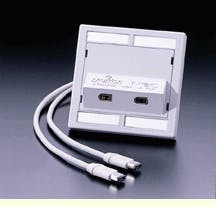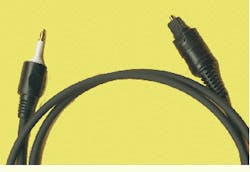The medium`s future may be brightest in residences, not corporate networks.
Patrick McLaughlin
Proponents of plastic optical-fiber (pof) technology may discover, much like Dorothy in The Wizard of Oz did, that truly there is no place like home. After several years attempting to gain acceptance as a viable medium for horizontal data-communications cabling runs, the pof industry has found that home networking, and particularly consumer-electronics applications, appears to offer a richer future. The residential networking environment is not new to the pof industry; plastic optical fiber has been used inside consumer-electronics equipment for a number of years. But now, pof is one form of media being used to link these devices together.
Custom-electronic applications aren`t necessarily the only target market for pof constructions, according to Edward Berman, president of Boston Optical Fiber (Westboro, MA), the only U.S. manufacturer of pof cable. "We`re targeting high-speed applications, regardless of whether the location is in a corporation or in the home," he says. "Over the past few years, pof`s focus in the United States has been on office networks. But recent developments in home electronics and the ability to network those electronics have presented an opportunity for pof applications in these environments."
While the pof industry was focusing on corporate networks, it made some strides. In May 1997, pof was recognized and approved by the atm Forum, an organization founded to speed the development and deployment of Asynchronous Transfer Mode (atm) products and services. The atm Forum approved pof as a viable medium for use in 155-megabit-per-second atm horizontal links to 50 meters.
That approval made Berman and others in the pof industry optimistic that other standards-making bodies would follow in recognizing the medium. But, despite the optimism, pof has not enjoyed any additional recognition by standards-makers. And Berman notes, "With Ethernet being deployed as widely as it is in corporate networks, being recognized only for atm applications does not guarantee a lot of product demand from pof component makers."
FireWire-compliant products
One of the turning points that has opened other doors to the pof market is the maturation of the 1394 "FireWire" standard, originally ratified by the Institute of Electrical and Electronics Engineers (ieee--New York City) in December 1995. Officially named ieee-1394 "1995 Standard for a High Performance Serial Bus," the standard gets its nickname from its forerunner--Apple Computer`s original FireWire design. In 1994, more than a year before the ieee ratified the final standard, the 1394 Trade Association was formed to accelerate adoption of the bus by PC and consumer-electronics manufacturers. Since 1995, a revision in the form of 1394A has been released, and a 1394B standard is in the works.
"FireWire defines a high-speed serial bus within the 1394 standards and can move large amounts of data between computers and peripheral devices," says Frank Murawski, a consultant with ftm Consulting (Hummelstown, PA), based on his analysis of technology trends in the home-wiring marketplace. Murawski also says that the application "speeds up the movement of multimedia data and large files, enabling the interconnection of consumer digital electronic devices...directly to a PC."
The medium specified in the existing FireWire standard is not pof, he points out. "The FireWire cable is currently specified as a six-conductor cable consisting of two separately shielded twisted-pair transmission lines for signaling and two power conductors with an overall shield."
Murawski believes that a copper-wiring solution rather than a pof solution would be an economical and practical approach to home wiring. One problem, he says, has been the lack of success to date of economically manufacturing large quantities of high-speed pof. He adds that future standards may reflect this copper-wiring approach to home networks, analogous to the specification of copper wiring in the tia/eia-568a Commercial Building Telecommunications Cabling Standard
Component makers on board
However, recent product developments by component manufacturers leave open the possibility that pof has a future in 1394-based networks. Several hardware makers have released 1394-compliant pof products. Packard Hughes Interconnect (Irvine, CA), for instance, is a member of the High Speed Plastic Network (hspn), a program funded by the Defense Advanced Research Projects Agency (darpa) to extend pof technology. The company has developed the hspn duplex pof connection system, a family of components that includes a duplex cable connector, transceiver module, wallplate, and patch-panel connectors. The duplex connector is designed to accept 750- or 1000-micron pof and use either a polish or hotplate end-finish technique. Simplicity is a key for the Packard-Hughes hardware; the connectors consist of two snap-together components.
In January, Leviton Manufacturing (Little Neck, NY) and nec Corp. (Tokyo) jointly introduced the prototype of the Range Extending Module-1 (rxm1). The concept, which is based on an nec transceiver, is undergoing development pending the release of the 1394B standard by the ieee. The rxm1 accommodates glass optical-fiber and unshielded twisted-pair (utp) cable as well as pof cable. According to a release issued announcing the product, it can extend the range of 1394-compliant products.
ftm`s Murawski elaborates: "The current 1394 standard includes a cable-connecting virtual bus supporting data rates of 100, 200, and 400 Mbits/sec, with speeds up to 1.6 gigabits per second for future versions. Due to the high speed, the distance between each node or hop should not exceed 4.5 meters, and the maximum number of hops in a chain is 16--for a maximum end-to-end distance of 72 meters. Cable distance between each node is limited primarily by signal attenuation. The distance limitations would not hinder use in home-wiring networking because of the short distances involved within home networks." The Leviton/nec development claims to give pof users an operating range to 100 meters and speeds to 200 Mbits/sec.
Molex Inc. (Lisle, IL) has developed two pof connector systems--the PN series and smi (Small Multimedia Interface) series. The PN series is currently under review by the 1394B committee, while the smi series is being considered by a large consumer group in Japan, led by Sony. "pof interconnect systems are at the leading edge of ieee 1394 interconnect technology," says Molex product manager Bill Kysiak, adding that Molex is "poised to meet market demands" for the products.
Boston Optical Fiber has introduced OptiMal, a line of pof cables, electronics, and connectors. The "Mal" in OptiMal stands for Miniature Active Link, and the connectors are available in Toslink- and Miniplug-compatible formats. Boston Optical Fiber says the links are designed for use in digital television, home and office networks, and industrial-control applications. The company continues to emphasize that pof is a more robust medium than utp cables and easier to handle and terminate than glass optical fiber.
Specifications include fiber attenuation of less than 0.18 decibel/meter, a fiber bend radius of five times the core diameter, and connection loss of less than 0.5 dB. The transceivers operate at 12.5 Mbits/sec.
OptiMal is one of several product lines available from Boston Optical Fiber and the only one targeted specifically toward the home-network and consumer-electronics markets. Other lines include OptiGiga, a local area network (lan) cable that, like OptiMal, uses graded-index pof. According to the company, the cable is equipped to handle 3 Gbits/sec. The OptiSilica cable, also a graded-index product, is compatible with OptiGiga and is ieee-1394-compliant. OptiMega is a step-index cable designed to be low in cost and to accommodate transmission speeds to 200 Mbits/sec. HiLite is a lighting product that competes with conventional lighting systems.
In addition to being used in the corporate lan, home-networking, and lighting arenas, pof historically has been implemented in a number of areas. It is deployed in communications systems in automobiles and aircraft, as well as in the medical community.
Two types of pof available
Currently, two types of pof are available, and a third type is under development. Step-index pof is made of polymethylmethacrylate, or pmma. DuPont (Wilmington, DE) developed the technology in the late 1960s and early 1970s and sold its patents to Japanese manufacturer Mitsubishi Rayon. Not coin-cidentally, the Japanese market has embraced pof for a number of years while the medium has jostled for market position in the United States.
In 1992, Japanese researcher Yasuhiro Koike developed and published research results on graded-index pof, which provided the medium with the capability to handle higher bandwidths than what was possible with step-index fiber. The same year, Boston Optical Fiber was formed and obtained a license to develop and commercialize graded-index pof technology and products. Shortly thereafter, the federal government turned its attention to pof for use in military and industrial environments. darpa formed the hspn and other similar groups with similar charters.
The next level for pof, according to Berman, involves fluoropolymers. He explains that although pof transceivers are available at 650 nanometers, the material does not function at telecommunications wavelengths of 850, 1300, and 1550 nm. Fluorinated pof, he says, operates over a broad range of wavelengths that includes 850 and 1300 nm.
The originator of pof technology, DuPont, likely will play a part in the new technology`s development. Berman reports that Boston Optical Fiber has been using DuPont`s fluoropolymers as the company develops the next generation of pof.
The Range Extending Module-1, produced by Leviton Manufac- turing and nec Corp., was displayed for the first time at January`s Consumer Electronics Show in Las Vegas.
Boston Optical Fiber`s OptiMal miniature links are compatible with Miniplug (left) and Toslink (right) connection interfaces.

